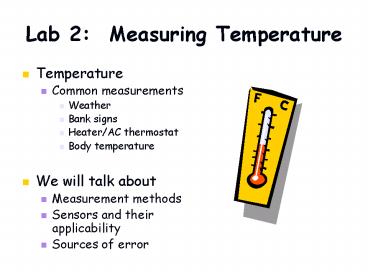Lab 2: Measuring Temperature PowerPoint PPT Presentation
1 / 20
Title: Lab 2: Measuring Temperature
1
Lab 2 Measuring Temperature
- Temperature
- Common measurements
- Weather
- Bank signs
- Heater/AC thermostat
- Body temperature
- We will talk about
- Measurement methods
- Sensors and their applicability
- Sources of error
2
Common Temperature Sensors
- Change in volume of gas or liquid
- Alcohol or mercury
- Increase in T ? Increase in volume
- Calibrated according to temperature
- Example Mercury Thermometer (why mercury?)
- Bimetallic Strip
- Two different metals with different coefficients
of thermal expansion (CTE) - Bonded together
- Bend proportional to temperature
- Calibrate to get temperature
- Example Thermostat
3
Infrared Transducers
- Measure intensity of IR radiation
- Intensity proportional to T4
- Useful for measuring temp of surfaces (remote)
- Chapter 10
4
Electronic Methods
- Good for data logging
- Store temperature values without anyone present
- Preserve T maximum, minimum, hourly, etc.
- Come in many shapes and sizes
- Important to know where and when each is
appropriate
- Basic Types
- Thermocouples
- Thermistors
- Platinum Resistance Thermometers (PRT)
- Integrated circuit (chip) sensors
5
Basic Electronics Review
- Units
- Voltage (V) - Volts potential difference that
drives electron flow - Current (I) - Amps flow of electrons through a
circuit - Resistance (R) - Ohms resistance to current
flow - Power (P) - Watts energy dissipated by current
flow through a circuit - Ohms Law V IR
- P VI
6
Thermocouples
- Two wires of dissimilar metal joined together
- Sebec effect two junctions at different T will
produce an electrical current
current
7
Thermocouples
- Voltage can be measured across open circuit
- Voltage proportional to ?T
T1
T2
Voltmeter
8
Thermocouples
Reference Temperature
- Voltage response to temperature can be logged
- MUST KNOW TEMPERATURE AT ONE JUNCTION (Tref)
Constantan
Cu
To logging Device
9
Calculating Thermocouple Temperature from Voltage
- Ref Temp 22.5 C
- Measured TC voltage 0.98 mV
- Cu-Constantan TC calibration 40 µV/C
TC Temp ?
10
Calculating Thermocouple Temperature from Voltage
- Ref Temp 22.5 C
- Measured TC voltage -0.13 mV
- Cu-Constantan TC calibration 40 µV/C
TC Temp ?
11
Thermocouple Cautions, Advantages and
Disadvantages
- Reference T must be measured at the TC reference
junction - Advantages
- Inexpensive
- Many sizes
- No individual output
- (somewhat) Linear calibration
- Disadvantages
- Changes in µV are difficult to measure
- Requirement for accurate reference temperature
measurement
12
Thermistors
- Change resistance with temperature
- R vs. T relationship follows form
- where a and ß are calibration constants for
individual thermistors
13
Thermistor response
14
Thermistor response
15
Reading thermistors
Or, use a resistance meter
16
Thermistor
- Disadvantages
- More expensive
- Require individual calibration
- Limited size and shapes
- Generate heat internally if not set up properly
- Advantages
- Output easily measurable when set up properly
- No reference temperature requirement
17
Other Temperature Devices
- Integrated circuit (chip)
- Often use a diode
- Look at voltage drop across PN junction
(semiconductor) at a constant current - Advantages
- Linear with temperature
- Disadvantages
- Complex circuitry
- Platinum Resistance Thermometer
- Electrical resistance increases 0.4 per oC
- Similar circuit to thermistor (see lab chapter)
- Advantages
- Excellent calibration stability
- Excellent accuracy
- Disadvantages
- Lower voltage increase per oC than thermistor
- More expensive than thermistor
18
Temperature Measurement Errors
- Assuming calibration is good
- Errors are due to difference between thermometer
and medium - Time constant of device
- Radiant heating
- Heat flow in thermocouple wires
- Requires high thermal resistance in wires
19
Time Constant
- Body temperature example
- If t 0.5 min, Ti 20 oC and Tf 37 oC, what
will the temperature be after 1 minute? - 2.3 oC below actual
- Waiting 5t will result in a reading within 1 of
actual
- Time constant (t) time to change to 63 of final
reading - Time constant depends on
- Heat capacity of sensor (cp)
- Rate of heat transfer
- What happens to the time constant if we increase
cp?
20
Radiant heating of thermometer measuring air
temperature
- 100 degrees in the shade
as short wave absorptivity Si Solar
radiation d diameter of thermometer Cp
specific heat of air u windspeed

